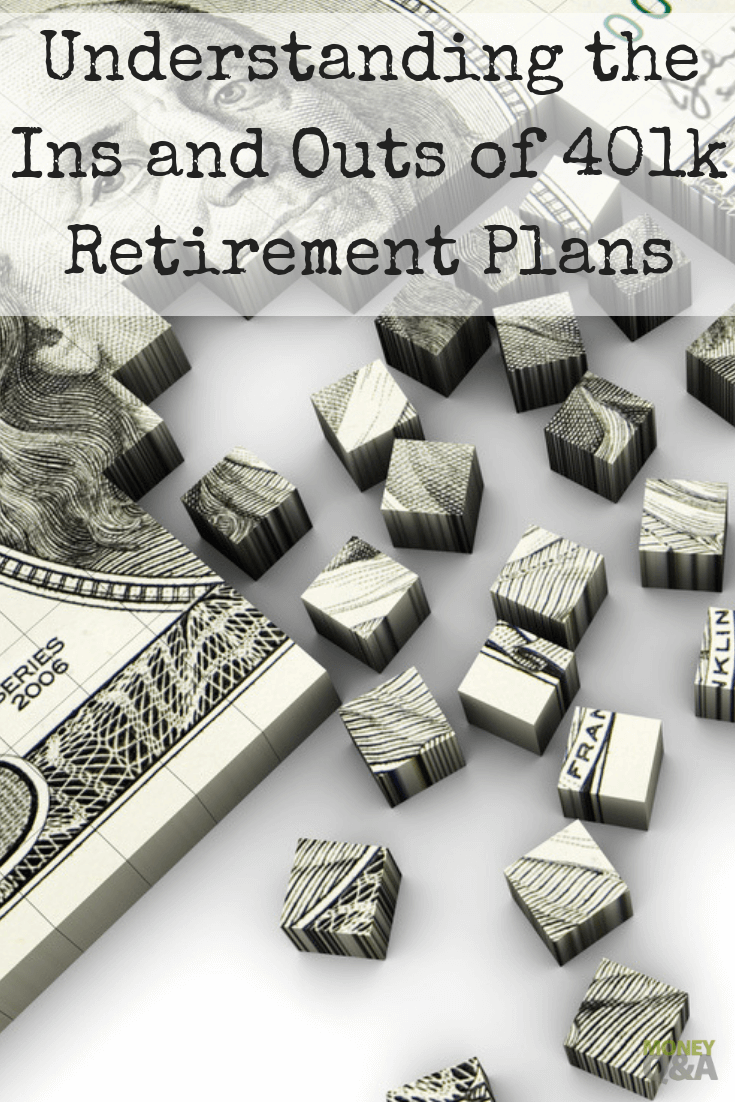What if you were told that you could invest in a savings plan at work where each dollar you put into it is taken off the top? Or, the amount of your contribution will lower the amount you pay in yearly income tax? You need to understand the ins and outs of 401k retirement plans!
Also, every dollar and cent you fund the account with will grow tax-deferred. Not only that, each of your 401k retirement plan contributions will make it possible for your employer to match those amounts as well.

The Basics of a 401k Retirement Plan
The 401k Retirement Plan is still the backbone of most Americans’ retirement planning, and it should be. When combined with the Roth IRA, a 401k Retirement Plan is a great tool to help you accomplish your financial goal of retiring. While there is Social Security still available, the younger generation should not count on much in the way of benefits in 30 or 40 years. Your 401k Retirement Plan will be the main focus in your retirement portfolio. It is important to understand the basics of a 401k Retirement Plan.
Every year, more and more companies are switching from pensions to 401k plans to save costs and put the burden of saving for retirement onto the individual.
Here are some of the basics of a 401k Retirement Plan that you need to know.
The Saving Period
Your 401k Retirement Plan is a defined contribution plan sponsored by your employer. This is the opposite to a SIPP pension in the UK, which is independent of your employer. A 401k is designed to be a savings vehicle for retirement or even THE primary savings tool for your retirement.
From within your 401k Retirement Plan, you can typically choose to buy different types of investments that your employer’s plan provides. Most plans offer a wide variety of mutual funds, index funds, and may include an option to purchase company stock.

Your Employer’s Obligation
The reason it is called a defined contribution plan is that employers have no further obligation to save for your retirement for you as they did with a traditional pension plan. Their obligation ends with ensuring that the program is run correctly (typically by an outsourced company) and then to contribute their matching 401k contribution if you are lucky enough to work for an employer who matches.
By this, I mean that most 401k plans offer some type of employer match to the employee’s contribution. Once this match is made, the employer has no other guarantees associated with the account.
One great resource to manage your 401k retirement plan is Blooom. Let the experts at bloom take a free peek at your 401k. Get real advice on how it’s doing and how it could be performing better. When you become a member, Blooom then makes trades to optimize your account based on your goals. Blooom can manage your 401k, 401a, 403b, 457, or Thrift Savings Plan (TSP).
Taxes and Your 401k Retirement Plan
One of the great things about a 401k Retirement Plan is that all of the contributions are made with pre-tax money. You can reduce your current taxable income by contributing to your 401k Retirement Plan. However, the 2012 limit to contributions is $17,000, with an additional $5,500 catch-up contribution if you are over the age of 50.
During the period of time that the money is in the 401k Retirement Plan account, it will grow tax-deferred until you withdraw it. If you move employers, you typically have four options: roll your current 401k into your new employer’s 401k, roll your 401k into a traditional IRA, leave it in your old employer’s 401k Retirement Plan account, or cash it out.
You should avoid cashing it out if at all possible because of the taxes and penalties that you will pay when you do if you are under the age of 59 1/2. You should also have the transfer sent directly to your new employer’s 401k Retirement Plan in order to help you from accidentally holding onto the funds too long and qualifying for a disbursement in the IRS’s eyes.

Withdrawals from Your 401k Retirement Plan
Once you reach retirement age and are looking to spend money from your 401k Retirement Plan, you will have to pay taxes on your withdraws. Many 401k Retirement Plans offer the option of continuing to keep your 401k with the company, convert your 401k into an annuity offered by the company, or roll your 401k over into a traditional IRA.
Easy Way to Save Without Thinking About It
You certainly wouldn’t say “no” to such an opportunity, would you? Of course not, at least not if you want to enjoy your days fishing, playing golf or volunteering your services when you retire. What is nice about a 401k retirement plan account is that every single dollar you put into the plan is put to use.
For example, say you draw a salary of $800 per week. If you invest, for example, 2% of your income, $16.00 will be spread across a broad range of investments of your choosing. You do not even have to think about your contributions as the money is automatically withdrawn from your paycheck.
The Magic of Tax-Deferred Savings
The major advantage of a 401k account though is that is comprised solely of pretax money. Therefore, say, you make $8,400 per year and fall under a 15% income tax bracket, each dollar invested into your account reduces your tax amount by 15 cents.
Or, for example, if you make $172,000 per year and fall in with the individuals who are in the 33% tax bracket, then each taxable dollar that goes into a 401k is reduced by 33 cents.
Dollar Based Investment
If you only invest $600 per year or $50 per month and fall into the lowest tax bracket of 10%, it is the same as investing the equivalent of $660 in after-tax dollars.
Therefore, regardless of your salary, dollar for dollar, most people are typically wise to take advantage of 401k retirement plans if it is offered to them at work. If you work in a non-profit organization, then a 403(b) plan is the “401k” option for you.
Benefits of 401k Retirement Plans for Investors
What makes 401k retirement plans or similar retirement accounts so appealing is that it offers investors a way to invest that is realizable. Therefore, they do not have to worry about going through a broker or middleman, and can open an account for a minimal amount of money that will also lower the amount in taxes they pay.
In a rocky market, a 401k retirement plan is an ideal investment choice to make. Put your hard-earned cash into a 401k retirement plan versus placing a pittance in the account and allocating the lion’s share of your money into other investments.
Of course, the 401k retirement plans should have a good selection of investment options. Equity categories represented should include small-cap, mid-cap, and large-cap stocks as well as bond classes, international, growth, balanced and income-based offerings. If you feel your 401k does not offer good choices, then make your voice heard to the administrator of the account.
There are many things that contribute to understanding the basics of a 401k Retirement Plan. While they are not an overly complicated investment tool, there are many moving pieces and rules to consider when investing and especially when you withdraw your funds from the account.
Do you have a 401k Retirement Plan through your employer? Are you contributing enough to capture their matching contribution?


Everyone should take advantage of a 401k. More and more employers are making it a requirement for their employees to enroll when hired. At bare minimum everyone should put away whatever your employer is matching…it’s free money!
You are absolutely right. Capturing your employer match should always be your first priority.
Did you know that every dollar one puts into a Qualified Plan above the match hurts their rate-of-return? It does and simple math proves it.
I feel there is one thing missing from this post and it has to deal with the second thing that 401(k)s defer. You see, we always hear that they defer our taxes for this year. This should really be “postpone”. Did you know Dave Ramsey says on Pages 154-155 of his Financial Peace Revisited book that someone who contributes to a 401(k) only has to pay the government back what he/she put in? Absolute nonsense and people actually believe him.
Anyway, the second thing that Qualified Plans defer (postpone) is the tax calculation. Let that run through your brain real slow. Do you feel we’re in an increasing, decreasing, or stable tax environment? Also, who controls the pen on these deals, you or the government? When someone has $200,000 in a QP how much of that is theirs? No one can say because they have a partner and that partner decides at the time of withdrawal how much to take.
There are so many issues with qualified plans and those who are serious about their money need to learn the impacts of them going forward compared to the opportunity of maintaining liquidity, use and control of their money in order to leverage.
I’ve written pretty extensively about this but I’m not one to post my blog on another’s.
Kelly,
While I hope that taxes do not rise in the future, I do hope to be in a higher tax bracket in the future thanks to raises, a sizeable nest egg, and the like nevertheless which would be the same as an increasing tax environment. Because of being in a higher tax bracket, investing while you are younger (after capturing your employer’s match to your 401k) should most likely benefit you in a Roth IRA if the investor is eligible where after-tax dollars are invested and grow tax free.
I totally agree with you Hank. After tax dollars that grow tax deferred and can be used tax free is the way to go. I would challenge the tool suggested though; after all, who controls the pen (rule book) on Roth IRAs, you or the government? What if you’ve done quite well and want to contribute more money? What if you’d like to use it before the age of 59 1/2?
It’s interesting what Senator Roth from Delaware actually proposed for the Roth IRA compared to what was approved. Would it be prudent to investigate a tool that had all the benefits of a Roth but the government’s hand was off? That’s a huge variable in of itself that must be understood!! What if you weren’t limited on your contribution amount? The pro-athletes I work with sure LOVE that one single benefit.